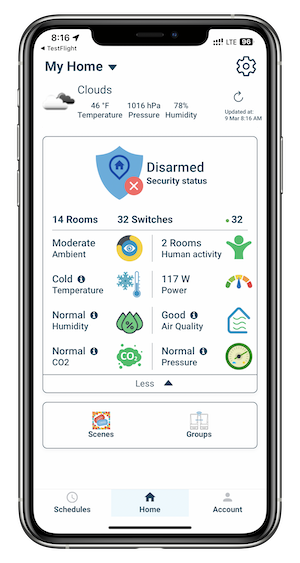
Advisor, Nuro Technologies

In the pursuit of healthier, more sustainable living, we often focus on aspects like nutrition, exercise, and mental well-being. While these are undoubtedly vital, there’s another area that often goes unnoticed: the health of our homes. Yes, your home – like a living organism – has health parameters that can be measured, monitored, and improved. Key parameters include temperature, carbon dioxide (CO2) levels, Indoor Air Quality (IAQ). Occupancy patterns can be monitored to identify anomolies in living pattern especially with elders and kids. Monitoring these can provide crucial insights into the overall health of your home environment, impacting not only the longevity of the home itself but also the well-being of its inhabitants.
Environmental parameters within a home play a critical role in determining its ‘health’. These parameters are intertwined, each influencing and being influenced by the others, contributing to a complex ecosystem that impacts not only the structural integrity of the building but also the health and comfort of its occupants. Let’s look into the impact of some of the parameters.
Monitoring these parameters can help detect potential problems early on, much like regular health check-ups can detect and prevent severe illnesses in humans. For instance, issues like poor insulation, inadequate ventilation, excess moisture, or high pollutant levels can be identified and rectified before they escalate into significant health hazards or costly repairs.
Moreover, understanding these parameters can guide us to make informed decisions about home improvements. Are energy-efficient appliances needed to regulate temperature better? Should there be an investment in a high-quality air purifier to improve IAQ? Or perhaps implementing smart technologies for better occupancy management to save energy? These are the kinds of strategic questions homeowners can answer with a good grasp of their home’s health parameters.

Indoor environments significantly influence our health and well-being, given that we spend a large portion of our time indoors. Unfavorable conditions in our homes—be it poor air quality, inadequate lighting, or uncomfortable temperature variations—can lead to a range of health issues from minor discomforts like headaches or allergies to severe conditions such as asthma or chronic fatigue.
Monitoring home health parameters allows for the creation of an optimal living environment. By ensuring that parameters like temperature, air quality, and lighting are within appropriate levels, homeowners can promote better sleep, higher productivity, and overall improved well-being among the home’s inhabitants.
Advances in smart home technologies have made monitoring home health parameters more accessible than ever. Homeowners can now use smart devices and sensors to continuously track various environmental factors and even receive alerts when parameters deviate from the norm. This real-time data can be used to automate home systems for optimal comfort, energy efficiency, and longevity of the building.
From smart thermostats and air quality monitors to automated lighting and occupancy sensors, these devices not only facilitate a proactive approach to home health management but also enable a more sustainable and energy-efficient lifestyle. Let’s look into the impact of some of these parameters
Temperature
The temperature in your home is more than just a matter of comfort. Consistently high or low temperatures can signal insulation issues, leading to increased energy consumption and higher utility bills. Temperature fluctuations can also affect the durability of building materials and the lifespan of electronic devices. Furthermore, abnormal temperatures can impact human health, exacerbating conditions like asthma, allergies, or arthritis. Monitoring home temperature can help identify issues early, allowing for timely interventions and adjustments.
Pressure
Air pressure inside a home can significantly impact the comfort and well-being of its inhabitants. Unbalanced pressure can lead to drafts, uneven temperature distribution, and increased entry of outdoor pollutants. It can also contribute to moisture problems, leading to mold growth and other structural damage. Regular pressure monitoring can help detect these issues before they escalate, enhancing.
Carbon Dioxide (CO2) Levels
We exhale CO2 every time we breathe. Normally, this isn’t a problem, but in a poorly ventilated room, CO2 levels can quickly rise, leading to headaches, restlessness, difficulty concentrating, and even health risks over time. By monitoring CO2 levels, smart home systems can automatically adjust ventilation to maintain a healthy atmosphere.
Indoor Air Quality (IAQ)
IAQ is a comprehensive measure that includes pollutants like dust, smoke, volatile organic compounds (VOCs), and allergens. Poor IAQ can lead to a variety of health problems, from minor issues like allergies and asthma to serious conditions like heart disease and cancer. Advanced home monitoring systems can track these pollutants and control them using air purifiers, dehumidifiers, and ventilation systems.
Occupancy
Monitoring occupancy – who is in the house and when – allows for more efficient use of energy and enhances security. For example, heating or air conditioning can be automatically adjusted based on the number of people in the home, saving energy when fewer people are present. Occupancy sensors can also contribute to home security by alerting homeowners to unexpected activity when they’re away from home.
The Healthy Home Ecosystem
These are just a few of the parameters that can be measured to monitor the health of a home. A comprehensive home monitoring system can integrate all these parameters, using artificial intelligence (AI) to learn patterns and make real-time adjustments. For example, it could detect a rise in CO2 levels during a party and increase ventilation, or adjust temperature and lighting based on the time of day and occupancy.
Moreover, a smart home can provide actionable insights for homeowners. For example, persistent high humidity might indicate a water leak, while high VOC levels could suggest off-gassing from new furniture or cleaning supplies. By alerting homeowners to these issues, smart homes allow for proactive maintenance and healthier living environments.
The Future of Healthy Homes
As technology advances, we can expect home monitoring systems to become even more sophisticated and integrated. They will become more predictive, able to anticipate changes based on learned patterns and external factors such as weather forecasts. They will also become more responsive to individual preferences, creating personalized environments for each member of the household.
BriteHome solution monitors these parameters like temperature, pressure, CO2, IAQ, and occupancy and more. They even raise alert when these parameters breach the threshold. They can be easily integrated with other systems to make real time adjustments.